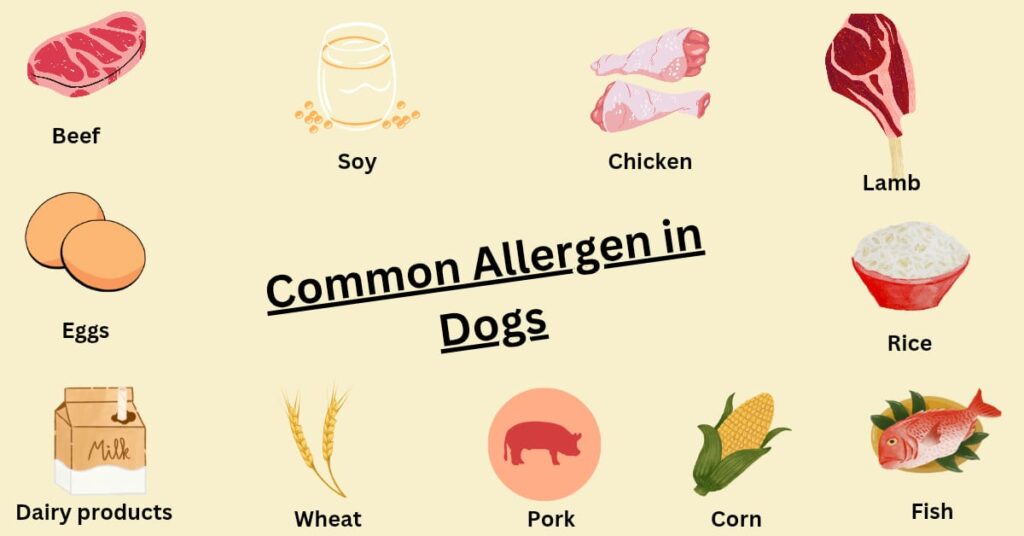With so many dog food options available in the market. Making it difficult to find the best dog food for allergies. Common ingredients like beef, chicken, or grains can trigger allergic reactions in dogs. Vomition, diarrhea, itchy skin, and sensitive stomachs can affect a dog’s health and well-being. Identifying potential allergens and selecting dog food that avoids these allergens is easy. Such foods promote digestion and provide proper nutrition without causing allergies or digestive issues.
Is It a Food Allergy or Intolerance?
Knowing the difference between food intolerance and food allergies helps you choose the right diet for allergies and sensitive stomachs.
Adverse Food Reaction (AFR) in dogs is the term used to describe the abnormal response to “normal food.” There are two main types of AFRs: 1. Food allergies 2. Food Intolerance
Food Allergy
A dog’s immune system mistakenly identifies protein from food as harmful. The dog’s body reacts by producing defensive antibodies to fight against the perceived invader.
Dog food allergies take a longer time to develop. The common food allergens in dogs include protein from chicken, beef, and dairy.
Itching, swelling, vomiting, diarrhea, and gas are common clinical signs in food allergic dogs. However, food allergies are rare, affecting only 0.2% of dogs.
Food Intolerance
Food intolerance means the dog has difficulty digesting certain ingredients, like dairy. It does not involve the dog’s immune system response.
The culprit ingredient causing problems in intolerance may be protein or other ingredients.
Food intolerant dogs can handle small amounts of food, whereas even trace amounts can trigger a true food allergy in dogs.
Dr. Kong explains that food allergies are managed rather than cured. The best way to help is to identify the allergens and avoid them. This often involves switching to hypoallergenic dog food or a limited-ingredient dog food.
Many dog owners choose grain-free dog food for allergies or novel protein dog food to avoid common allergens like chicken and beef.
Veterinary Insight
True food allergies in dogs are uncommon, affecting less than 1% of the dog population. Most cases labeled as ‘food allergies’ are food intolerance or sensitivities, which do not trigger an immune system response” –Dr. John Thomason, DVM, DACVIM (Texas A&M University College of Veterinary Medicine
Why do Dogs Develop Allergies and Food Intolerance?
Several ingredients cause food allergies or intolerances in dogs. Proteins are the most common allergens involved. Allergies or intolerances can develop at an early stage of life or take several years to develop.
What Are Allergens In Dog Foods?
Allergens are substances that trigger food sensitivities in dogs. These can be proteins or other ingredients found in dog food for allergies that the immune system mistakenly identifies as harmful. Common allergens in dog foods include
Breed-Specific Predispositions
Now that we’ve identified common allergens, let’s look at which dog breeds are more susceptible to food allergies.
Certain breeds, such as Golden Retrievers, Labrador Retrievers, West Highland White Terriers, Cocker Spaniels, Irish Setters, Dalmatians, Boxers, Boston Terriers, Scottish Terriers, Shih Tzus, Wirehaired Fox Terriers, and Lhasa Apso, are more prone to food allergies and intolerances.
Digestive Upset and Gut Health
Poor gut health and microbial imbalance can make dogs sensitive to certain foods, which triggers allergic reactions or intolerance.
Weakened digestive system- Poor gut health can impair digestion and the absorption of nutrients.
Chronic digestive issues like diarrhea, bloating, and gas may indicate food intolerance rather than a true allergy.
Symptoms of Food Allergies and Food Intolerance in Dogs
Despite different underlying causes, food allergies and food intolerance have similar clinical signs.
- Hair loss
- Licking/chewing feet
- Itchyness and redness of skin
- Frequent ear/skin infection
- Vomiting
- Excessive gas (flatulence)
- Diarrhea
- Weight loss
- lethargy
- Hives and facial swelling
Diagnostic Methods for Food Allergies in Dogs
Food allergies, also known as adverse food reactions (AFR), are relatively rare in dogs but can pose significant diagnostic challenges for veterinarians and pet owners. Diagnosis requires accurate testing and appropriate dietary choices.
Elimination Diet and Re-challenge
The gold standard method for diagnosing food allergies in dogs involves feeding a novel protein or hydrolyzed protein diet exclusively for 8-12 weeks, then reintroducing potential allergens to observe reactions
Blood and Saliva Tests
Studies found that this method is inaccurate in differentiating between healthy and allergic dogs. Tufts University highlighted that this method is ineffective for diagnosing food allergies.
How to Choose the Right Dog Food for Allergies and Sensitivities?
Hypoallergenic Dog Food
Hypoallergenic dog food severe allergies
Grain-Free Dog Food
Grain-free dog food Grain Sensitivities
Limited Ingredient Dog Food
Limited ingredient diet Simplifying Diet
Novel Protein Dog Foods Best for Dogs Allergic to Common Proteins)
The Role of Gut Health in Food Sensitivities
Where to Add: After Digestive Upset and Gut Health
Why? Supports the idea that a strong gut microbiome reduces food sensitivities.
🛠 Suggested Addition:
Fermented foods for dogs (e.g., kefir, yogurt)
Probiotics & Prebiotics: How they improve digestion
Omega-3s & Digestive Enzymes: Supporting gut lining



